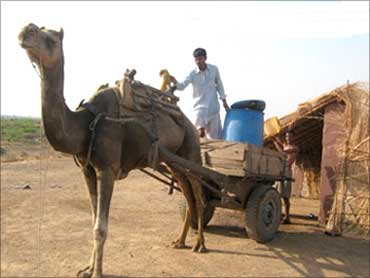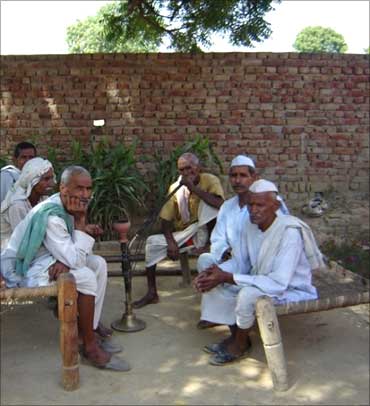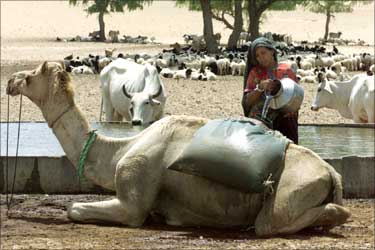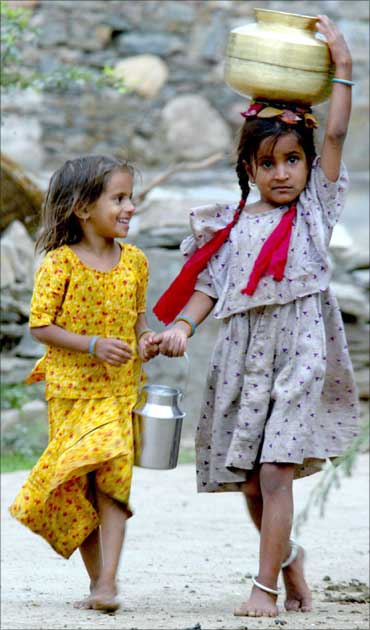Photographs: Courtesy, Yatra Foundation Akshat Kaushal in Rajasthan
Neem Singh's daily bread comes from water. He draws water from a kuin (small well), fills a metal container reminiscent of the trunk used for storing clothes, and takes it back to the village pulled by his camel-cart -- the tyres of which are the same as used in jets.
For each journey he makes, which would be half a kilometre, he gets Rs 50. Ask him how much he earns and he says: "In summer I make at least five-six such trips. On a good day, I am able to make Rs 300-400."
Singh's village is Netsi (district Jaisalmer in Rajasthan). It lies in the heart of the 200,000 sq km Thar desert. With an average annual rainfall of less than 16 cm (Delhi has an average rainfall of 61.7cm), it is one of the driest regions of the country. To make matters worse, the groundwater here is saline, which also makes it unsuitable for agriculture.
So, how do the people here survive? "Water is abundant here," claims Singh. A minute later, pointing towards his camel to show the absent hump, he adds: "Water is not a problem, though we don't have enough fodder for the cattle."
...
How parched villages save water in Rajasthan
Image: A typical jat chaupal.Traditional ingenuity
Eager to know how they are able to have "enough water" despite having no permanent source and very little rainfall, we visit the chaupal in Singh's village in the hope of getting an insight.
As we enter, we hear someone saying he can predict where and how much it would rain by just noticing the angle of lightning. Others, meanwhile, discuss whether it would be a drought this year, too. Almost all the discussions here are surrounding rain, which is understandable, as it's on which the whole water management system is dependent.
The water preservation methods followed here are believed to have been developed by the Paliwal brahmins around 500 years ago. They were the first to notice the gypsum belt which lies below the surface of sand.
Gypsum is a non-porous element, which doesn't allow water to seep through. When raindrops fall on the surface of sand, its particles start behaving like sponge and absorb every drop of this water. Over a period of time, water gets deposited between the upper layer of sand and the lower layer of gypsum belt.
The gypsum belt, because of being non-porous, prevents it from reaching the level of the groundwater, thereby preventing it from getting saline.
...
How parched villages save water in Rajasthan
Image: A villager pours water into a bag on a camel's back.Photographs: Kamal Kishore/Reuters
Due to the extreme heat, some of this gets evaporated. However, unlike mud, sand is made up of very fine grains which aren't interconnected. Due to which, even in conditions of extreme heat, which makes the ground completely dry, cracks don't appear on the surface. As a result, moisture trapped at the lower level doesn't evaporate.
In contrast, regions of Bundelkhand and Vidharba, despite receiving much more rainfall, have very low water tables as the groundwater there evaporates due to the swelling of the land.
This storing of water between the layers by nature has been continuing for centuries. Villagers found this to be helpful and constructed small wells called kuin to extract this.
The moisture patch, when it comes in contact with the cavity of the well, gets transformed into droplets of water and starts getting accumulated inside the well. This water is then used for drinking purposes.
The popularity and dependence of these wells can be gauged from the fact that in Netsi alone, which has around 30 houses, 23 kuins exist; some of which are at least 500 years old. However, none are owned by any one person.
Farhad Contactor, whose NGO Sambhaav has been working in the maintenance of these wells says: "These wells are constructed communally and don't belong to any individual. Anyone from the village can go to any well and draw water from it irrespective of caste or community."
Developed at a cost of around Rs 10,000, these are able to provide water for centuries to come.
...
How parched villages save water in Rajasthan
Image: Women drawing water from the well.Broken promises
Across the road which runs from Ramgarh to Longewala, a series of interconnecting canals exist, which were constructed two decades ago, when the government had decided to irrigate the desert by bringing in water from the Himalayas.
The scheme was simple: Transferring of excess water from states like Punjab to Rajasthan. It was impressive on paper, and thousands of crores of taxpayers' money were spent on its implementation.
In fact, the canal being talked about here extends from Ramgarh to Gadra Road (Pakistan border). The planned length of the last stretch of the canal for Phase 2 Stage II of the project is 125.20 km. The work completed as of now is believed to be around 92 km.
The official name of the project was earlier Rajasthan Canal Project when it was started in 1958. Later it was renamed as Indira Gandhi Canal Project.
The Ramgarh-Gadra road (close to India's border with Pakistan) stretch is known as "Baba Ramdev shakha". In 1992, when construction of the stretch was started, its cost was pegged at Rs 725 crore (Rs 7.25 billion). Completion of 92 km of the canal has already cost Rs 400 crore (Rs 4 billion).
The then Congress government under chief minister Ashok Gehlot was at the helm in the state. He is the chief minister of Rajasthan now, too.
...
How parched villages save water in Rajasthan
Image: Two village girls carry home water.Photographs: Pawel Kopczynski/Reuters
The local farmers, who never imagined that their arid land would ever become fertile, gave all possible help to the government. Chattar Singh, a farmer in Ramgarh, says: "Others and I who had tractors used to bring the water from tubewells and wells for filling the canals. It was the last time I saw water flow in this canal."
He tells us that many farmers sold their land and bought land near the canal as the government had promised irrigation.
Today, in these canals - which were hugely publicised as great engineering marvel and even found its way in school textbooks - nothing flows except sand. The land on which agriculture was promised, decaying corpses of cattle lay.
Centuries later, when even the virtues of modern technologies have failed to ensure even the availability of irrigable water, traditional methods are ensuring that enough water is available for everyone to drink.
Anupam Mishra, who wrote the book Rajasthan Ki Rajat Bunde explaining the traditional methods of water conservation followed throughout rural Rajasthan, says: "The people here realised the importance of water centuries ago before we in cities did, and have developed a lifestyle around it in which they conserve every drop of water that falls on the surface."







article